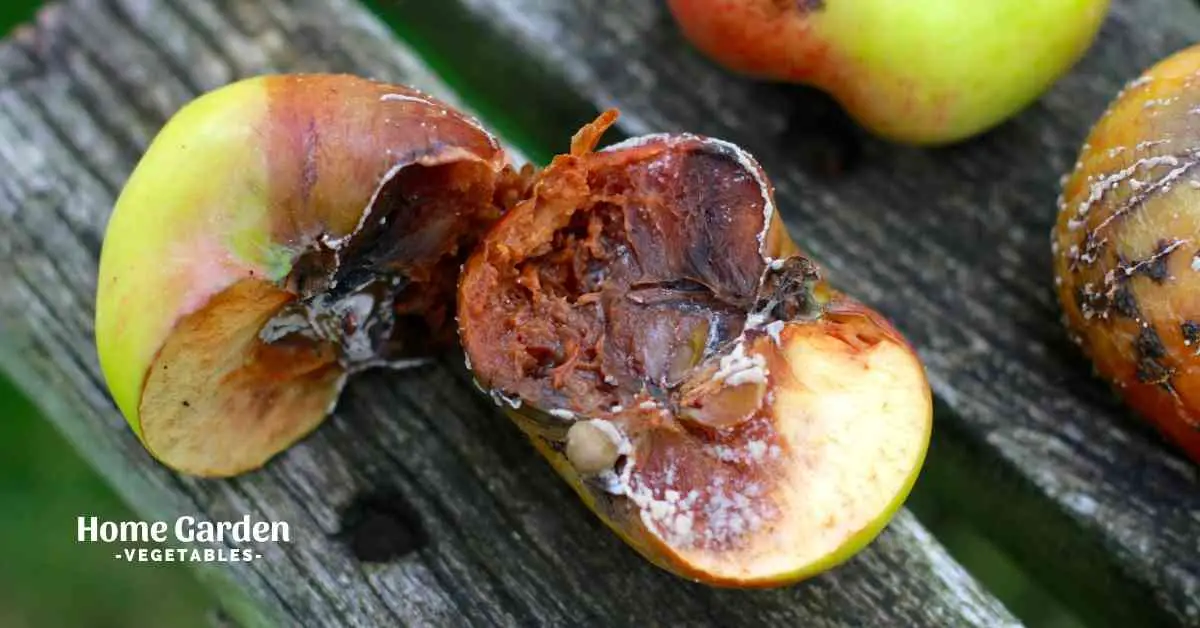An apple tree is a beautiful sight in any garden. Yet, being able to grow those flawless, blemish-free apples isn’t as easy. Keeping your tree well-watered, fed, pruned and safe from pests and diseases are all important tasks to achieve those perfect apples.
Apple rotting on tree is far from what you had been waiting for. What does it mean, and what should you do? Read this post to learn about all the different problems that result in fruit rotting on the apple tree before ripening.
Reader Poll: What online courses would interest you?

List Of 4 Possible Diseases That Cause Fruit Rot In Apples
A number of different diseases can be responsible for fruit rot in apple trees. It’s important to investigate the symptoms further to clearly identify which fungus is bothering your tree and then treat it accordingly. Here’s a list of diseases that cause apples to rot on the tree.
Brown Rot
This is a fungal disease caused by the fungi Monilinia laxa and Monilinia fructigena. Brown rot not only attacks apple trees, but also pears, plum, cherries and many ornamental trees. The symptoms typically appear from mid-summer onwards. You will notice brown rot on fruits, typically extending outwards from wounds made by birds and codling moth. The infection can quickly spread to other fruits in the same cluster. Once infected, the fruit will either fall to the ground or remain on the tree as a mummy.
The rotting areas on the fruit are surrounded by raised, cream-colored pustules, often in concentric circles. This is a classic symptom of brown rot, distinguishing it from other diseases.
Subscribe to our newsletter!
Remove and dispose of all the rotting fruit to prevent the infection from spreading to the healthy parts of the tree. Prune out the infected blossoms and twigs and coat the exposed cuts with protective paint. Since fruits wounded by bird damage are the ones most susceptible to developing a rot, protect them by using netting.
Bitter Rot
This is another common fungal disease that causes fruit to rot on apple and pear trees. Bitter rot is caused by either of the three closely related fungi, Colletotrichum gloeosporiodes, C. acutatum and Globally cingulata. Bitter rot is more prevalent in warm, humid conditions and symptoms typically appear between July and August.
As the fruit matures, it’s susceptibility to developing rot increases. Brown, sunken rot spots typically appear on the side of the fruit that’s exposed to the sun. The lesions expand as the temperatures rise, with severely infected fruit shriveling and mummifying on the tree.
Bitter rot is managed by good sanitation practices and chemical control.
Prune out all the dead and diseased branches and mummified fruits to remove sources of inoculum. If the tree has been infected by bitter rot in the previous seasons, you can start applying fungicides at the first fruit set. Continue applying them at the recommended frequency and dosage until harvest.
Bot Rot / White Rot
Bot rot or white rot are two different names of the same disease, caused by the fungus Botryosphaeria dothidea. Other than apples and crab apples, the fungus also attacks pears, grapes, and many other woody plants. Trees stressed by winter injury, drought, fire blight, and pest infestations are the ones that are most susceptible to being infected by bot rot.
Fruits grow more susceptible to bot rot as they mature. The infection manifests as small, slightly sunken spots surrounded by a red halo. Eventually, the fruit will rot completely to the core. The disease is called white rot because the apple cultivars with red skin turn light brown with the infection. While the spot in bot rot starts in the shape of an egg, that in bitter rot is shaped like a cone.
To control the infection prune out infected branches and burn. Maintain the correct watering and feeding to control the disease. Cultural control can also be coupled with fungicide applications to manage the problem.
Black Rot
Another possible reason for apples rotting on tree could be the fungus Botryosphaeria obtusa. This fungus causes an infection called black rot in apples. Fruit, leaves and the bark will also become infected. Fruit infection begins when the pathogen attacks the flowers and is transferred to the developing green fruits as tiny red or purple pimples. These spots enlarge as the fruit grows. Eventually they grow bigger into concentric bands of black and brown rotten areas. It often results in mummification of the fruit on the tree.
Fungal spores overwinter on mummified fruit, dead branches and cankers. These are the areas that need to be pruned out during the dormant season. Destroy all the infected tissue immediately by burning it or burying it deep underground, away from your garden. Alongside cultural control, general-purpose copper-based fungicides can also be applied for faster management of the problem.
Braeburn, Creston, Enterprise, and Fuji are some of the varieties that are less susceptible to black rot. These cultivars will make good choices for growing in a garden with a history of black rot infections in the previous seasons.
Conclusion
So these are all the diseases that can cause apple rotting on tree. No matter which fungus is bothering your apple tree, good sanitation practices, pruning of the infected limbs and keeping the tree well-watered and lightly fed will keep the damage to a minimum and revive your tree in due time.

